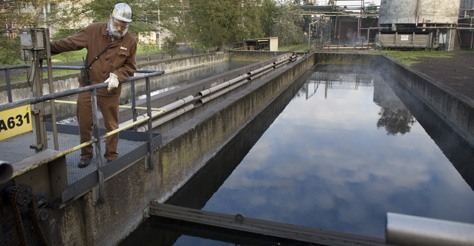-
Top notch biological water purification
In the coking plant, coal is transformed into coke. During this process, polluted water is formed due to organic contaminants. We purify this water in our state-of-the-art biological water purification installation.

The water purification is done in two steps: First, the contaminants are microbiologically reduced to water, CO2 and other nitrates in an oxygen injected basins. Next, the nitrates are transformed into nitrogen.
Germs at work
The micro-organisms that purify the waste water, are the so-called ‘garbage eating’ bacteria. Different families of this type of bacteria help in purifying the impure water. The following table gives us an overview of the different processes:
Offered pollution load Altered by Via a chemical reaction transformed into C6H5OH (phenols) Organic bacteria
(family pseudomonas)C6H5OH + 7O2 → 6CO2 + 3H2O + energy Organic carbon and nitrates Organic bacteria
(family pseudomonas)C + 2NO3 + 2H+ → N2 + 5/2O2 + H2O + CO2 + energy S2O3 (thiosulphates) Chemolithotrofe bacteria
(family thiobacillus)S2O3 +2O2 + H2O → 2SO4 + 2H+ + energy CNS (thiocyanates) Chemolithotrofe bacteria
(family thiobacillus)CNS- + 2O2 + 2H2O → SO2 + NH4 + NH4 + CO2 + energy NH4 (ammonium) Chemolithotrofe bacteria
(family nitrosomonas)NH4 + + 3/2 O2 → NO2 + H2 + 2H+ + energy NO2 (nitrites) Chemolithotrofe bacteria
(family nitrobacter)NO2 + ½ O2 → NO3 + energy Closed circuit
In the sedimentation basin of our biological water purification installation, micro-organisms are- as much as possible- kept separate from the purified water.
The sedimentation is, once formed, scraped off for the main part and then sent back to the oxygen injection installation. Around 20% of the sedimentation is been thickened before being sent back to the coals supply (coking plant) so that it can be re-used in combination with coal. By doing so, we created a closed-off ‘garbage’ circuit which has no environmental impact.
-
More process innovation


